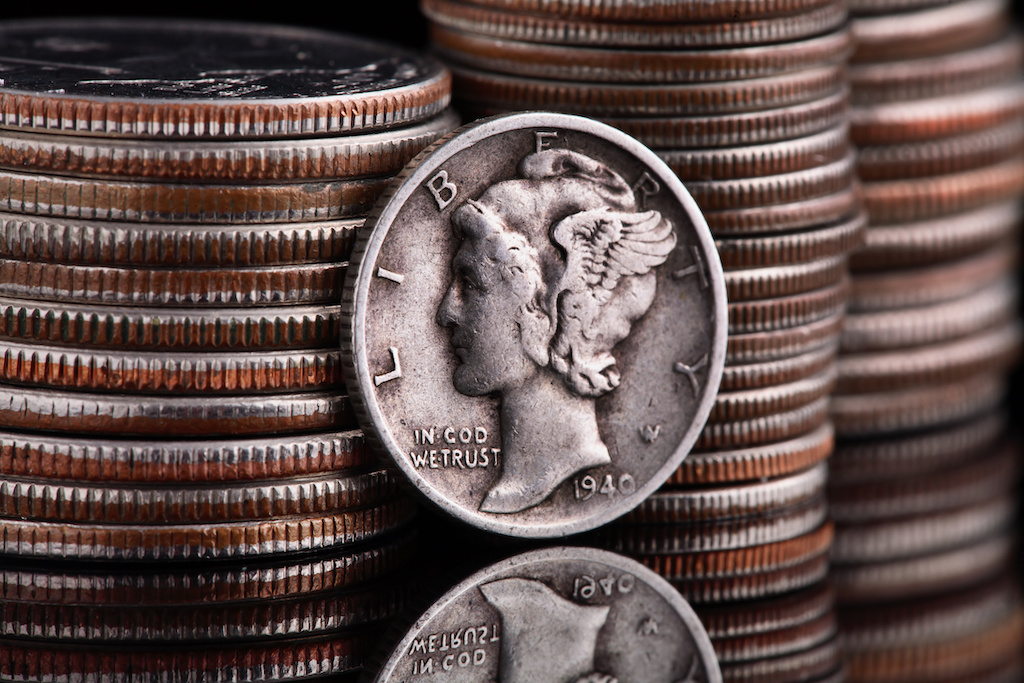Until 1965, U.S. dimes were composed of 90% silver and 10% copper. However, because of rising silver prices, the U.S. Mint decided to continue debasement of coinage by changing the composition of dimes to a copper-nickel alloy, starting with the clad coin production in 1965. The US Mint not longer issues silver dimes, instead, today’s dimes are of an alloy that is 91.67% copper and 8.33% nickel.
Silver dimes are ten-cent coins that were minted from 1796 to 1964, made from an alloy called “coin silver.”
Six different styles of silver dimes had been issued by the US Mint before 1965. Those include the Draped Bust, Capped Bust, Seated Liberty, Barber, Mercury, and Roosevelt designs.
Until 1965, U.S. dimes were composed of 90% silver and 10% copper. However, because of rising silver prices, the U.S. Mint decided to continue debasement of coinage by changing the composition of dimes to a copper-nickel alloy, starting with the clad coin production in 1965. Today’s dimes are of an alloy that is 91.67% copper and 8.33% nickel.
Silver Dime Variations
- Roosevelt Silver Dimes (1946-1964): These feature a portrait of President Franklin D. Roosevelt on the obverse side.
- Mercury Dimes (1916-1945): Despite the name, these actually depict a young Lady Liberty wearing a winged cap, which was mistaken for Mercury, the Roman messenger god.
- Barber Dimes (1892-1916): Named after their designer, Charles E. Barber, these dimes feature the head of Liberty on the obverse.
- Seated Liberty Dimes (1837-1891): These depict Liberty seated on a rock, holding a shield in one hand and an olive branch in the other.
- Capped Bust Dimes (1809-1837): These feature a portrait of Liberty wearing a cap, along with an eagle on the reverse.
- Draped Bust Dimes (1796-1807): These feature a portrait of Liberty with flowing hair and draped bust.
Collectors seek out silver dimes for their historical and numismatic value, while investors purchase them for their silver content as a hedge against economic instability or inflation. The industry refers to this as “junk silver,” although the term doesn’t reflect on the condition or value of the coin but rather means that its value comes primarily from its metal content rather than its rarity or collectibility.
Face Value Bags of Junk Silver
Online bullion dealers typically offer 90% silver dimes based on the face value that each contains. For example, each $5 Face Value standard bank roll of silver dimes has fifty individual pieces minted Pre-1965. Each circulated silver dime contains approximately .0715 troy ounces, with each standard $5 Bank Roll of silver dimes having a total of 3.575 troy ounces ASW.
Buying $100 Face Value bags of silver dimes provides one thousand individual dimes. These face value bags a popular way for new collectors to better understand the many rare dates, die variations, mint marks and error coins that are available. The intrinsic value of this bag is much higher than the face value due to the silver content of the coins.
Books About Silver Dimes
Pre-made Ten-Cent Coin Albums from Dansco and Whitman are an easy way for collectors to keep things organized and are available from Amazon and other retailers.
As a reference guide, many coin dealers use the spiral bound Guide Book of United States Coins, typically referred to as the “Red Book”, to help with pricing of collectible coins. The publish updates the guidebook each year making it one of the most common guidebook for collectors and investors alike.
